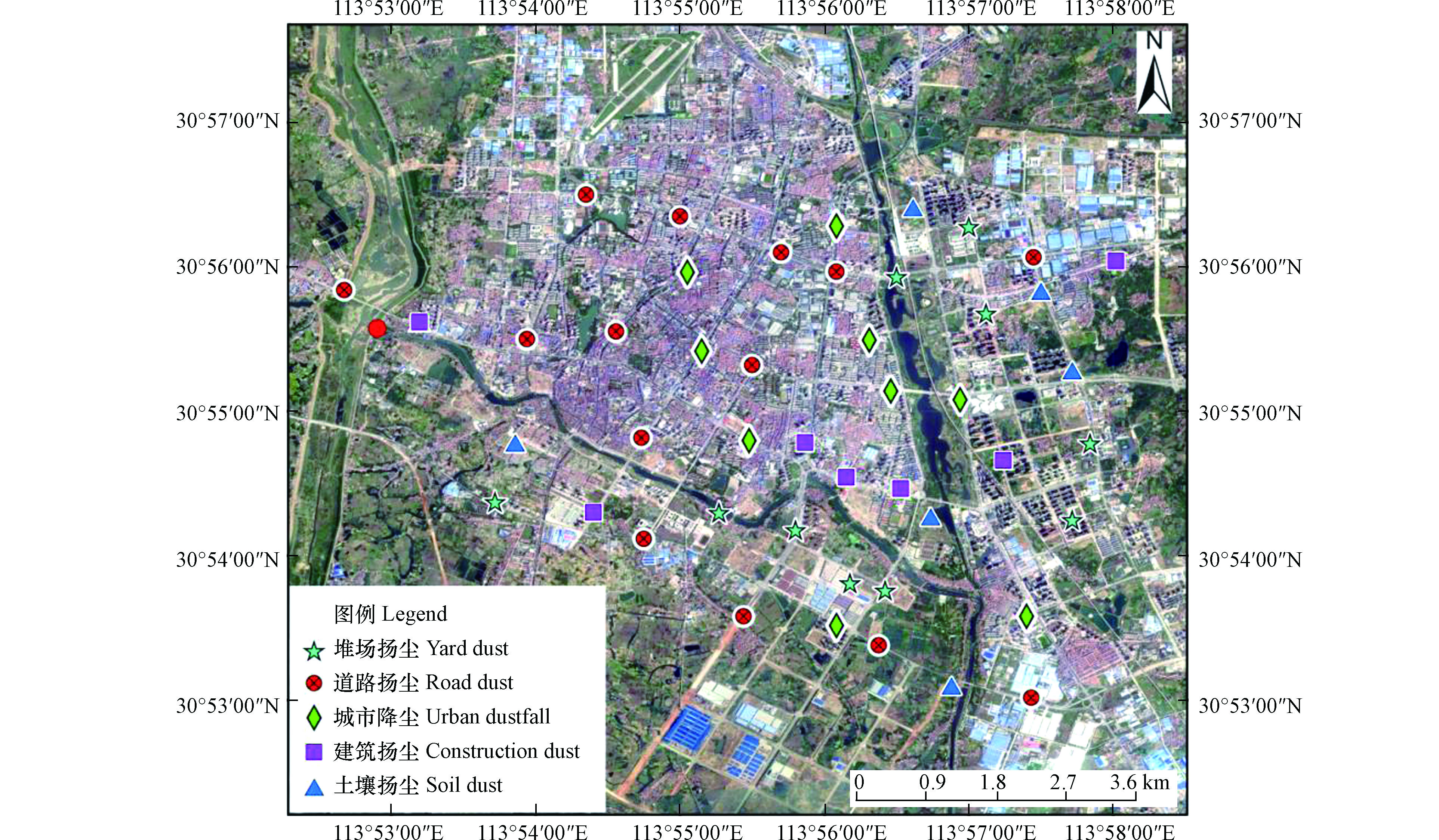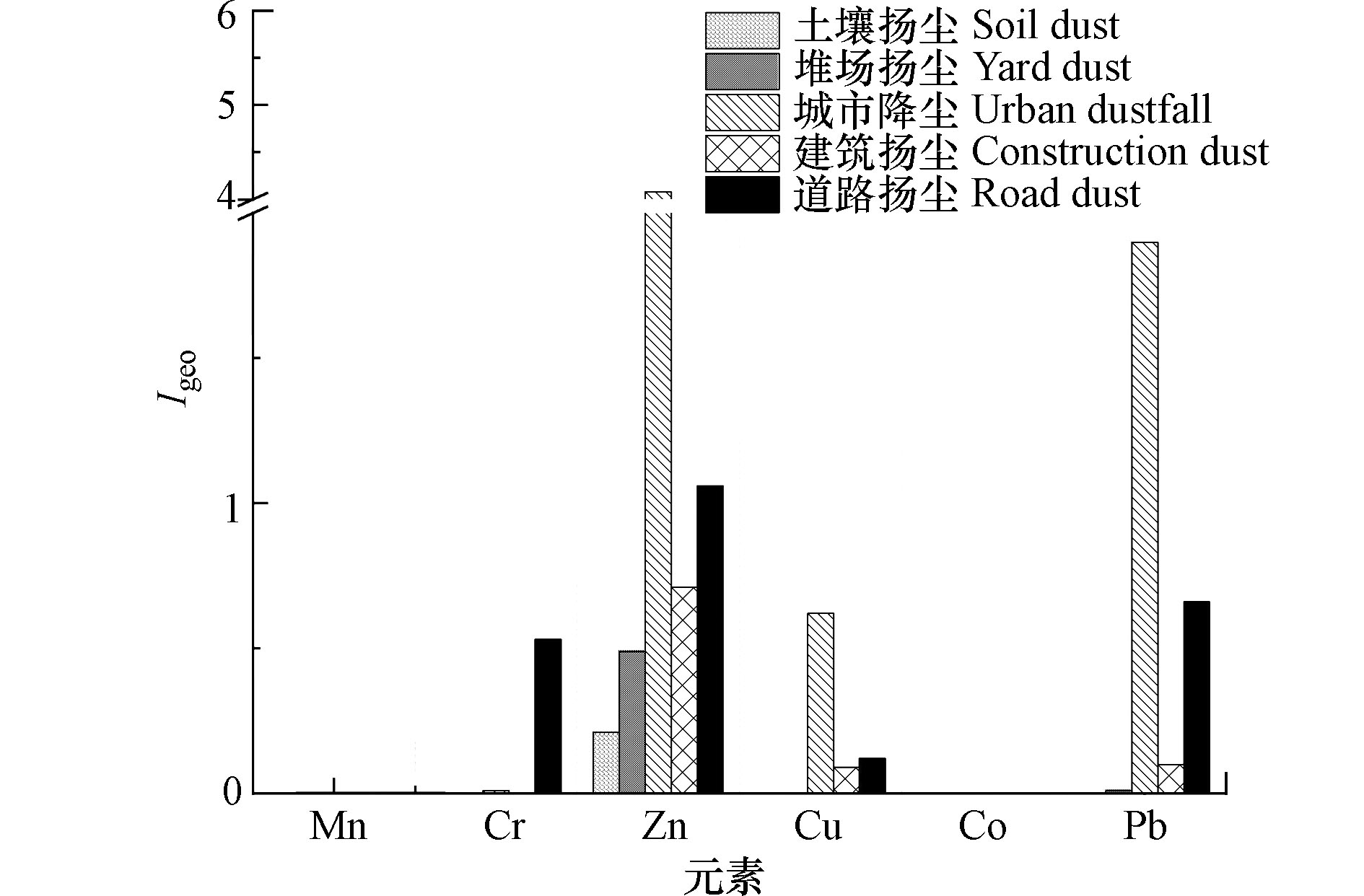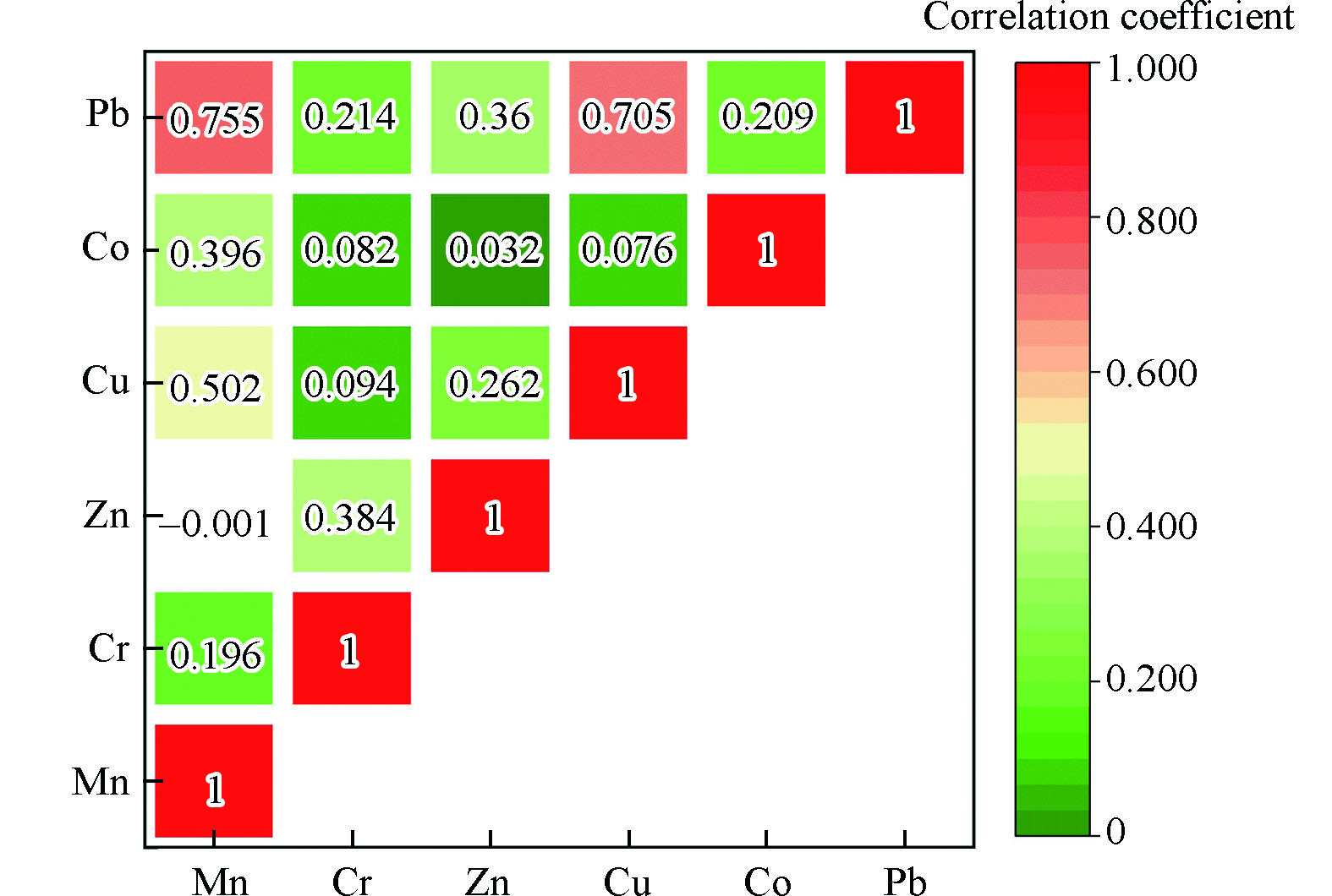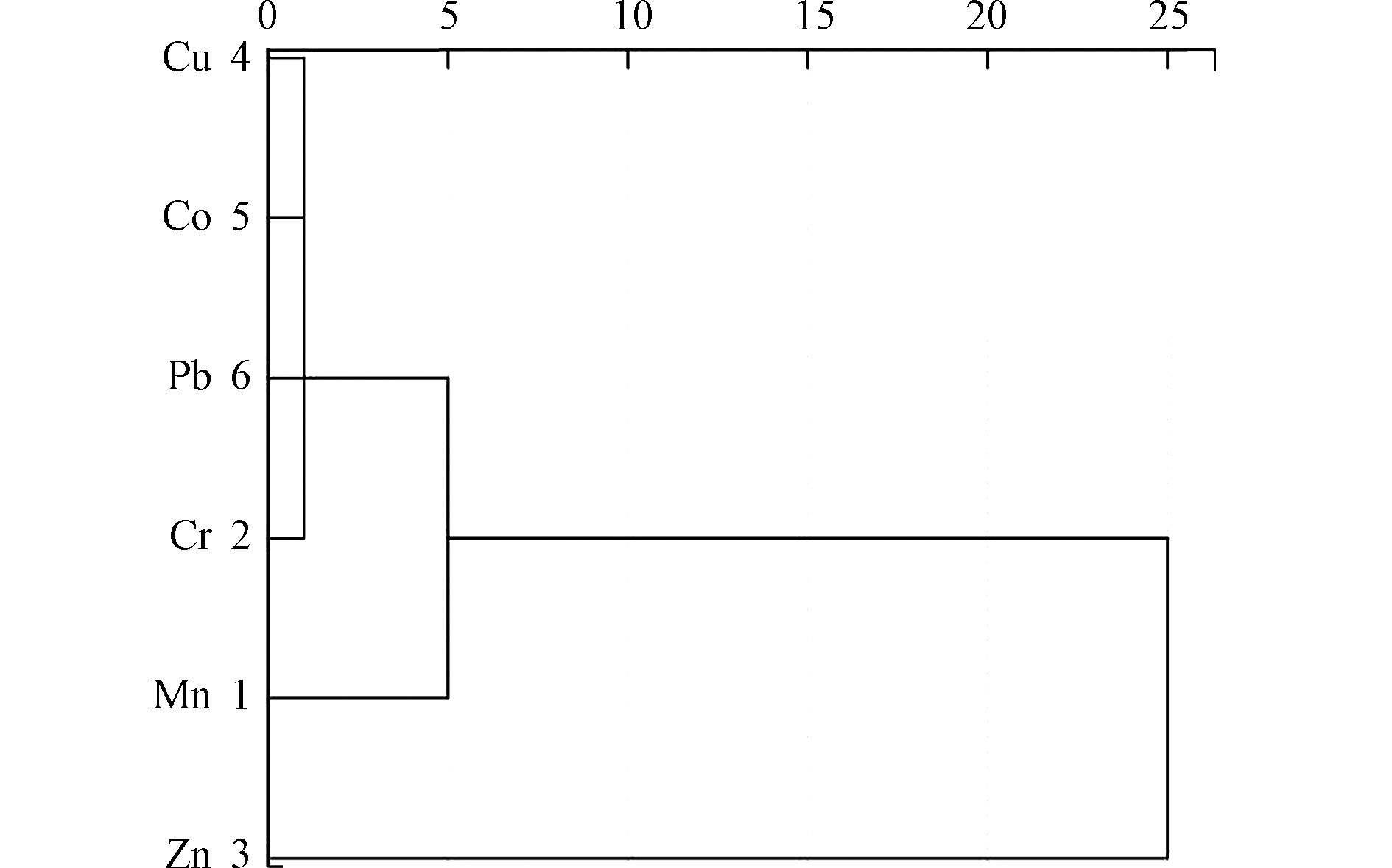-
城市地区大气颗粒物污染是我国大多数城市所面临的亟待解决的环境问题,也引起了政府、学者和普通民众的广泛关注。众所周知,大气颗粒物污染不仅影响大气能见度[1]、人体健康[2]、农业生产[3-4]和全球气候变化[5],而且会导致极大的经济损失[6]。大气颗粒物的来源多种多样,除了二次来源和燃料(煤、石油、生物质等)燃烧的贡献较大外,开放源扬尘也对大气颗粒物有重要贡献[7-8]。根据前人的大气颗粒物源解析结果来看,扬尘对大气颗粒物的贡献能达到46%以上[7]。由此可见,控制开放源扬尘对改善城市地区大气环境质量有着十分重要的意义。
一般而言,开放源扬尘主要包括道路扬尘、土壤扬尘、建筑扬尘、堆场扬尘和城市降尘。由于扬尘源具有源强不确定、排放不连续性和排放位置不确定等特点,因此对扬尘源的治理和管理更有难度。研究发现,扬尘不仅对大气环境造成污染,其携带的重金属、PAHs等污染物也会通过呼吸吸入和皮肤接触等途径进入人体,导致致癌风险增加[9-10]。国内已有较多学者对不同城市不同类型扬尘重金属污染特征及健康风险进行了研究[10-13]。例如,张文超等[10]对云南宣威道路尘重金属污染及来源进行了研究,并对金属元素对人体暴露的健康风险进行评价。Yang等[12]研究了在密集的城市建设时期,中国7个快速发展城市建筑尘中重金属元素污染及健康风险。胡月琪等[13]研究了2004年和2013年北京市代表性道路扬尘PM2.5中重金属污染特征及潜在生态风险。Men等[14]研究了北京市道路尘重金属污染水平、生态风险及来源。然而,针对同一城市地区不同类型扬尘重金属污染特征及健康风险的研究报道还较少见到。
孝感市位于湖北省东北部,是武汉“1+8”城市圈成员城市之一,也是国家新型城镇化综合试点地区。本研究采集了孝感市5种不同类型扬尘源样品(道路扬尘、土壤扬尘、施工扬尘、堆场扬尘和城市降尘),利用电感耦合等离子体发射光谱法(ICP-AES)测定其中重金属元素Cr、Co、Cu、Zn、Pb和Mn的含量,探讨了不同类型扬尘样品重金属的污染特征与健康风险,并通过相关分析和聚类分析法解析其来源,以期为制定有效的城市扬尘污染防治工作方案提供可靠科学的依据。
-
孝感市孝南区是孝感市下辖的县级行政区,属于孝感市唯一的建制区。孝南区东与武汉黄陂区接壤,北与孝昌县毗邻,西与云梦县、汉川市相连,南与武汉市东西湖区接壤,面积1020 km2。孝感市属亚热带大陆性季风气候,四季分明,春夏季雨水较多,秋冬季低温少雨,年平均降水量约1100 mm。孝南区属于高地平原地区,地势总体向南倾斜,西北部多为丘岗地形。
本次研究按照城市街道划分以及城市总体布局,根据科学合理的样品采集原则,对研究区域内的5种不同类型扬尘样品进行了采集,共采集扬尘样品47个,其中土壤扬尘7个,堆场扬尘10个,城市降尘9个,建筑扬尘7个,道路扬尘14个(图1)。采样时间选择在持续两周内无风无雨的晴朗天气条件下,采样过程中使用刷子和簸箕对每个采样点周边5 m2范围3—5处进行反复清扫收集扬尘样品,每个样品重约300 g,放入聚乙烯样品袋中进行保存并编号,以便后续带回实验室进行分析。采样同时,利用手持GPS记录采样点的经纬度信息并对采样点周围的环境状况做好详细记录。将所采集样品带回实验室后在通风、避光、室温的条件下进行自然风干,剔除掉大块砂石、杂叶枝条等物质后过1 mm尼龙筛,然后用玛瑙研钵研磨后过200目尼龙筛,密封于聚乙烯塑料袋中以备进一步分析。
-
称取约0.1 g制备好的样品,采用HJ 832—2017《土壤和沉积物 金属元素总量的消解 微波消解法》对样品进行消解,消解后的样品采用iCAP7200 Radial型电感耦合等离子体发射光谱仪(美国赛默飞)测定扬尘中金属元素 Cr、Co、Cu、Zn、Pb和Mn的含量。实验所用试剂均为优级纯,在分析过程中进行试剂空白和平行样的测定,并使用国家土壤标准样品(GSS-3和GSS-5)进行质控,回收率在85.6%—116.2%之间,各重金属的相对标准偏差均小于10%。
-
地积累指数(geoaccumulation index)是20世纪在德国发展起来的用于研究沉积物中重金属污染的评价指标[15],被广泛应用于土壤、街道尘、沉积物及大气颗粒物重金属污染研究[13, 16-18],计算公式为∶
式中,Igeo为地累积指数;Cn为重金属实测含量,mg·kg−1;Bn为元素地球化学背景值,mg·kg−1;1.5为修正系数,以考虑成岩作用可能会引起背景值的变动。本研究中以湖北省土壤背景值作为参考,其中Mn、Cr、Zn、Cu、Co和Pb背景值分别为712、86、83.6、30.7、15.4、26.7 mg·kg−1[19]。
地累积指数与重金属污染程度分级如下[18]∶Igeo≤0,清洁无污染;0<Igeo≤1,轻度污染;1<Igeo≤2,中度污染;2<Igeo≤3,中度污染到强污染;3<Igeo≤4,强污染;4<Igeo≤5,强污染到极强度污染;Igeo>5,极强污染。
-
采用美国环保署提出的健康风险暴露模型[20],对孝感市扬尘重金属的暴露剂量及风险进行计算。主要计算儿童和成人经口摄入途径的灰尘颗粒平均日暴露量(ADDing, mg·(kg·d)−1)、经呼吸吸入的灰尘颗粒平均日暴露量(ADDinh,mg·(kg·d)−1)和经皮肤吸收的灰尘颗粒平均日暴露量(ADDdermal,mg·(kg·d)−1)。呼吸途径的终生平均日暴露量(LADDinh,mg·(kg·d)−1)被用来评价致癌风险。具体计算公式如下∶
公式中各参数的含义与取值见表1。
灰尘的非致癌危险熵(HQ)、非致癌风险指数(HI)、致癌风险熵(CR)和致癌总风险指数(TCR)的计算公式如下所示∶
式中,HQi表示重金属非致癌健康风险指数;HI表示所有重金属非致癌健康风险指数;ADDi为非致癌物质的暴露剂量;RfDi是重金属摄入的参考剂量,SF为致癌斜率因子。RfD和SF取值见表2。
当HQ或者HI<1时,表示非致癌风险较小,可以忽略;当HQ或者HI>1时,表示有非致癌风险[10]。当TCR<10−6表示致癌风险较小,可以忽略;当TCR介于1×10−6—1×10−4之间是可接受的范围;当TCR>10−4时,有致癌风险[21]。
-
孝感市不同类型扬尘重金属元素含量统计结果见表3。不同类型扬尘中Mn、Cr、Zn、Cu、Co和Pb的平均含量分别为716.4、127.6、574.3、42.9、17.9和69.0 mg·kg−1,其中Mn含量最高,Co含量最低。土壤扬尘相对于其他扬尘类型来说,重金属含量最低(除Co外)。城市降尘中Mn、Cu、Zn和Pb含量明显高于其他扬尘,说明城市降尘重金属富集程度最高。
城市降尘和道路扬尘中Cr、Pb、Mn、Zn、Cu和Co元素含量平均值均高于湖北省土壤背景值,说明6种元素均受到人为活动干扰。城市降尘Zn平均含量达到2124.2 mg·kg−1,约是背景值的25.4倍,明显高于其他扬尘Zn含量,是其他扬尘Zn含量的8—14倍。污染最轻的土壤扬尘Zn平均含量约是背景值的1.7倍,说明Zn在不同类型扬尘中均呈现较高富集。土壤扬尘和堆场扬尘中Mn、Cr和Cu平均含量均低于或接近湖北省土壤背景值,说明受人为活动影响较小。除Mn外,建筑扬尘中Cr、Pb、Zn、Cu和Co元素平均含量均高于土壤背景值,说明这些元素均受到不同程度污染。
孝感市道路扬尘重金属含量与国内外其他城市的对比结果见表4。由表4可以看出,孝感市道路扬尘中Cu、Pb含量均处于较低水平,低于多伦多、卡瓦拉、首尔和成都,但高于许昌;Zn含量低于阿巴丹、首尔和成都,与北京和卡瓦拉相当;Mn含量远高于其他城市,仅低于多伦多;Cr含量高于车里亚宾斯克、阿巴丹、北京、成都和西安,低于多伦多、卡瓦拉和首尔;Co含量低于铜川,但高于车里亚宾斯克、阿巴丹和西安。与国内其他重工业城市(宝鸡、唐山)和农业城市(许昌)相比,孝感市道路扬尘重金属含量总体上低于唐山,比宝鸡稍高,但明显高于许昌。国内外不同城市道路尘中重金属元素含量的差异可能与其来源、自然环境条件、城市发展水平以及人类活动的强度和方式的差异有关。
-
利用Surfer 15.0软件对孝感市扬尘重金属元素含量采用Kriging方法进行插值,结果见图2。总体看来,Pb高值区出现在孝感市中心城区偏东南部,可能与该区域频繁的工业活动有关。中心城区以及工业园区附近扬尘中Cu含量较高。孝感市西北部、北部、南部和东南部分布有几条贯穿全市的国道、省道以及铁路,密集的道路交通会导致大量与机动车污染源相关的大气颗粒物的沉降,使得扬尘中Cu出现高富集[28-30]。Cr和Zn的高值区主要集中在孝感市北部距离工业企业较近的混合区,可能受到城区交通排放和工业活动的影响,因为Zn除了来自含铅汽油的燃烧和汽车轮胎磨损产生的粉尘外,也受到工业活动的影响[28,33];部分区域出现Cr和Zn高值的重叠,推断Cr同时也受交通因素影响。Mn的高值区主要位于中心城区偏北部;Co高值区在中心城区偏北、偏东南和西部出现。虽然Mn和Co在不同区域出现高值,考虑到扬尘中Mn和Co平均含量接近土壤背景值,说明这两种元素受人类活动影响较小,其分布特征大概率反映了土壤中元素的本底值。
-
孝感市扬尘重金属污染评价结果见图3。土壤扬尘重金属地累积指数平均值从高到低为Zn > Pb > Co > Cr > Cu > Mn;堆场扬尘重金属地累积指数为Zn > Pb > Co> Mn > Cr > Cu;城市降尘重金属地累积指数为 Zn > Pb > Cu > Cr > Mn > Co;建筑扬尘重金属地累积指数为Zn > Pb > Cu > Cr > Co > Mn;道路扬尘重金属地累积指数为Zn > Pb > Cr > Cu > Co > Mn。总体上,不同类型扬尘中Zn的地累积指数最高,污染最重,其次为Pb,而Co和Mn的地累积指数为负值,清洁无污染。
从图3可以看出,孝感市扬尘中Zn污染较为严重,在城市降尘中处于重度污染,在土壤扬尘、堆场扬尘和建筑扬尘中处于轻度污染,道路扬尘处于中度污染水平;城市降尘中Cr处于轻度污染,土壤扬尘、堆场扬尘、建筑扬尘和道路扬尘都处于清洁无污染水平;Cu在土壤扬尘和堆场扬尘中呈无污染状态,在城市降尘、道路扬尘和建筑扬尘中处于轻度污染水平;Pb在土壤扬尘中清洁无污染,在城市降尘中为中度污染,在堆场扬尘、建筑扬尘和道路扬尘中呈轻度污染水平;Mn和Co在不同类型扬尘中均处于无污染状态。总体来看,在5种不同类型扬尘中,城市降尘重金属污染程度最为严重,土壤扬尘污染程度最轻。
-
为探究孝感市5种扬尘中重金属的来源,利用SPSS 19.0软件对重金属元素含量进行相关性分析,结果见图4。由图4可以看出,元素Mn-Cu(0.502)、Mn-Pb(0.755)在P<0.01 水平上呈极显著正相关,推断3种元素具有较大的同源性和复合污染隐患。元素Cu-Pb(0.705)在P<0.01 水平上呈极显著正相关,说明Cu和Pb可能有相似的来源。
-
为进一步探究扬尘重金属的环境来源,利用SPSS 19.0软件对6种重金属元素进行聚类分析,分析结果见图5。由图5可以看出,第一类含有Cu、Co、Pb和Cr 4种元素,说明孝感市扬尘中这4种元素的地球化学性质或来源相似。Cu、Cr和Pb都是与车辆交通污染有关的指示元素[12, 32],所以交通运输过程中汽车尾气排放、轮胎和金属部件的机械磨损及润滑油的泄漏都会有一定的贡献。此外,Cu和Cr也会受到电子和冶金工业的影响[33]。Co 的污染与冶炼和采矿活动、化石燃料燃烧过程、不锈钢的加工生产等有关[34]。因此,第一组元素代表工业、交通混合污染源。
第二组元素为Mn。Mn在不同类型扬尘中含量普遍较低,其平均含量与湖北省土壤背景值相近。Mn被看作是自然来源的特征元素[35],也是土壤中的重要元素[29],可能源于土壤颗粒的悬浮和再迁移。由此可以推断出第二组元素来源于成土母质。
第三组元素只有Zn一种元素,但是与第一组和第二组组成一个更高水平的类别。Zn是交通污染的指示元素[21],由于研究区域分布有较多的交通干道,交通运输过程可能向环境中排放大量Zn,导致扬尘中Zn高度富集。也有研究发现,建筑工地的地基土壤也可能是Zn的来源[12]。Cu与Zn的相关性不好(图4),说明孝感地区Zn跟Cu的来源不同,除交通污染来源以外,Zn还受到其他人类活动的影响。王丽等[36]研究发现,西安市唐大明宫遗址公园、住宅区、交通区和商业交通混合区地表灰尘中Zn有高富集。由此推断,第三组元素来源于交通和生活混合污染源。
综上可以判断,孝感市扬尘重金属元素主要受到工业、交通和生活污染源的影响。
-
孝感市不同暴露途径5种扬尘中重金属对人体的暴露风险熵HQ和总非致癌风险 HI值见表5。从表5可以看出,不同暴露途径的重金属非致癌风险熵HQ大小顺序均为手-口摄入途径>皮肤接触途径>呼吸吸入途径,说明手-口摄入途径为主要的非致癌风险暴露途径,且不同暴露途径各重金属的非致癌风险熵HQ都呈现儿童高于成人的特征,这与很多城市的研究结论相似[10, 12, 21, 27]。不论对于成人或者儿童,手-口摄入和皮肤接触途径非致癌风险熵HQ最大的元素均为Cr,而呼吸吸入途径非致癌风险熵HQ最大的是Mn。不同暴露途径扬尘中不同重金属的非致癌风险熵HQ差异较大。各重金属对儿童的总非致癌风险HI的大小顺序为∶土壤扬尘Cr>Pb>Mn>Co>Zn>Cu;堆场扬尘Cr>Mn>Pb>Co>Zn>Cu;城市降尘Cr>Pb>Mn>Zn>Cu>Co;建筑扬尘Cr>Mn>Co>Cu=Pb>Zn;道路扬尘Cr>Mn>Pb>Cu>Co>Zn。可以看出,3种暴露途径重金属的总致癌风险指数HI最大的元素是Cr。3种暴露途径的非致癌风险熵HQ均小于美国环保署推荐的标准限值1,且所有重金属各种暴露途径的总致癌风险指数HI未超过1,说明孝感市扬尘重金属非致癌风险较小,可以忽略。但Cr是孝感市扬尘重金属导致人体非致癌健康风险的主要污染物,地方政府应加强对Cr污染的管理和防治。
孝感市不同类型扬尘重金属的致癌风险计算结果见表6。由表6可知,孝感市扬尘重金属Cr的致癌风险高于Co。不同类型扬尘Cr的致癌风险值大小顺序为道路扬尘>城市降尘>建筑扬尘>土壤扬尘>堆场扬尘,均在美国环保署推荐的可接受风险阈值(10−6—10−4)范围内;而不同类型扬尘Co的致癌风险值在同一个数量级且差异不大,明显低于阈值范围。扬尘重金属的致癌总风险指数TCR介于8.80×10−6—2.05×10−5之间,在可接受风险阈值(10−6—10−4)范围以内,说明孝感市扬尘重金属对人群不具有致癌风险。
-
(1)与湖北省土壤元素背景值相比,孝感市扬尘重金属元素处于低富集水平,但Zn存在一定污染。
(2)扬尘中重金属元素地累积指数表明Zn污染最严重,其次是Pb,Mn和Co清洁无污染,其中城市降尘污染最严重,土壤扬尘污染最轻。
(3)孝感市扬尘中重金属元素Cu、Co、Pb、Cd和Cr主要受工业、交通混合污染源的影响,Mn主要来源土壤母质,Zn主要来源于交通和生活混合污染源。
(4)儿童的非致癌风险HI值大于成人,手-口摄入途径是主要的非致癌风险暴露途径,其次是皮肤接触和呼吸途径。3种暴露途径重金属的总致癌风险指数HI最大的元素是Cr。不同类型扬尘Cr的致癌风险值高于Co,致癌风险总风险指数在可接受风险阈值10−6—10−4范围以内,说明扬尘重金属不会对人群产生致癌风险。
孝感市开放源扬尘重金属污染特征、来源及健康风险评价
Pollution characteristics, sources and health risk assessment of heavy metals in open-source dusts in Xiaogan City
-
摘要: 为了解开放扬尘源重金属成分谱特征,对孝感市孝南区道路扬尘、土壤扬尘、城市降尘、建筑扬尘和堆场扬尘进行调查取样,利用电感耦合等离子体发射光谱法分析扬尘中重金属的含量,并通过地累积指数法、相关分析、聚类分析和人体健康风险评价法对扬尘重金属污染程度和人体健康风险进行评价。结果表明,扬尘中Mn、Cr、Zn、Cu、Co和Pb的平均含量分别为716.4、127.6、574.3、42.9、17.9、69.0 mg·kg−1,均高于湖北省土壤背景值。地累积指数法评价结果显示不同类型扬尘中Zn污染程度最高,其次为Pb,Mn和Co清洁无污染,其中城市降尘污染最严重,土壤扬尘污染程度最轻。相关分析和聚类分析结果表明,Cu、Co、Pb和Cr 等4种元素主要受工业活动、交通污染源的影响,而Mn和Zn元素则分别来自土壤母质和交通生活混合污染源。健康风险评价结果表明非致癌风险暴露的主要途径是手-口接触,且儿童所受非致癌风险大于成人。不同类型扬尘单项重金属致癌风险指数和致癌总风险指数均低于10−4,说明不会对人群产生明显的致癌风险。Abstract: In order to understand the characteristics of the heavy metal composition in the open-source dust, five different types of dusts which contained road dust, soil dust, urban dustfall, construction dust, and stack yard dust were sampled in Xiaogan City, Hubei Province. The concentrations of heavy metals including Mn, Cr, Zn, Cu, Co, and Pb were measured by the inductively coupled plasma emission spectroscopy (ICP-MS), and the pollution characteristics, sources, and human health risk of heavy metals were evaluated. The results showed that the average contents of Mn, Cr, Zn, Cu, Co, and Pb in the dust samples were 716.4, 127.6, 574.3, 42.9, 17.9 and 69.0 mg·kg−1, respectively, which were all higher than the soil background values of Hubei Province. The pollution assessment by geo-accumulation index showed that the pollution level of Zn was the highest, followed by Pb, while Mn and Co were non-polluting. Among the five types of dust, the most serious polluted was urban dust and the least polluted was soil dust. The results of correlation analysis and cluster analysis showed that Cu, Co, Pb, and Cr were mainly affected by industrial activities and traffic pollution sources, while Mn and Zn might come from soil parent materials and/or mixed pollution sources of traffic and daily life. Human health risk assessment indicated that the major way of non-carcinogenic exposure was hand-mouth intake, and the non-carcinogenic risks for children were higher than those for adults. The carcinogenic risks of heavy metals in different open-source dusts were lower than 10−4, indicating that there is no carcinogenic risk.
-
Key words:
- dust /
- heavy metal /
- pollution /
- source /
- health risk /
- Xiaogan City
-
表 1 重金属日平均暴露量评价参数含义及取值[18]
Table 1. Evaluation parameters of average daily exposure to heavy metals
参数Factor 物理意义及单位Definition and Unit 成人 Adults 儿童 Children C 重金属含量/(mg·kg−1) 扬尘中重金属质量浓度 IngR 经手-口摄入量/(mg·d−1) 100 200 InhR 每日空气呼吸量/(m3·d−1) 14.5 7.5 CF 单位转换/(kg·mg−1) 1 × 1 × EF 暴露频率/(d·a−1) 350 350 ED 暴露年限/a 24 6 SA 暴露皮肤面积/cm2 5373.99 2848.01 SL 皮肤的黏附系数/(mg·(cm2·d)−1) 0.07 0.2 ABS 皮肤吸收因子(无量纲) 0.001 0.001 PEF 颗粒物排放因子/(m3·kg−1) 1.36 × 1.36 × BW 平均体重/kg 61.8 19.2 AT 平均暴露时间/d 非致癌作用:ED × × 项目Items Mn Cr Zn Cu Co Pb RfDing/(mg·(kg·d)−1) 4.60×10−2 3.00×10−3 0.30 4.00×10−2 2.00×10−2 3.50×10−3 RfDinh/(mg·(kg·d)−1) 1.43×10−5 2.86×10−5 0.30 4.02×10−2 5.71×10−6 3.52×10−3 RfDdermal/(mg·(kg·d)−1) 1.80×10−3 6.00×10−5 6.00×10−2 1.20×10−2 1.60×10−2 5.25×10−4 SF/[mg·(kg·d)−1]−1 42.0 9.8 表 3 不同类型扬尘重金属含量统计结果
Table 3. Descriptive statistics of heavy metal concentrations in different types of fugitive dust
项目Item Mn/(mg·kg−1) Cr/(mg·kg−1) Zn/(mg·kg−1) Cu/(mg·kg−1) Co/(mg·kg−1) Pb/(mg·kg−1) 土壤扬尘 变化范围平均值±标准偏差 126.7—541.4381.7±139.5 69.2—97.680.2±10.1 44.9—436.6144.6±136.5 8.8—28.317.9±6.5 11.9—23.918.8±3.9 15.8—72.539.9±21.0 堆场扬尘 变化范围平均值±标准偏差 377.6—1159.0661.7±208.8 50.3—94.977.8±11.8 61.7—669.7175.6±176.1 9.8—38.821.3±7.7 13.6—25.417.4±3.5 22.3—83.243.1±25.6 城市降尘 变化范围平均值±标准偏差 399.4—2151.7939.3±674.3 37.5—407.9129.5±108.4 104.6—10808.12124.2±3459.1 19.1—136.270.8±41.0 12.2—28.318.0±4.6 24.7—358.4149.9±111.6 建筑扬尘 变化范围平均值±标准偏差 551.1—863.4656.3±111.8 100.0—196.7125.0±34.8 81.6—261.5205.1±61.1 15.9—63.549.1±18.4 5.8—34.517.0±8.6 24.7—52.842.9±9.2 道路扬尘 变化范围平均值±标准偏差 532.6—1556.4803.3±280.8 102.9—570.8186.8±133.1 114.8—575.3262.2±154.6 15.6—102.549.9±28.4 13.5—25.418.3±3.3 14.7—139.063.1±42.6 全部扬尘 平均值±标准偏差 716.4±379.9 127.6±95.9 574.3±1637.0 42.9±30.8 17.9±4.6 69.0±67.4 湖北省土壤背景值[19] 712 86 83.6 30.7 15.4 26.7 表 4 国内外城市街道扬尘中重金属平均含量对比(mg·kg−1)
Table 4. Comparison of average content of heavy metals in street dust from different regions in the world (mg·kg−1)
城市 City Cu Pb Zn Mn Cr Co 参考文献Reference 车里亚宾斯克,俄罗斯 55.9 14.4 154 421 48.5 6.3 [22] 阿巴丹,伊朗 113 59 288 — 50 8 [23] 多伦多,加拿大 162.2 182.8 232.8 1407.2 197.9 — [24] 卡瓦拉,希腊 123.9 300.9 271.6 — 196.0 — [25] 首尔,韩国 353 128 1188 769 794 — [26] 北京,中国 97.37 62.29 255.90 536.29 99.50 — [14] 铜川,中国 32.6 75.2 141.8 369.1 106.4 34.0 [27] 唐山,中国 69.86 121.48 815.42 — 312.35 — [28] 许昌,中国 25.4 41.9 145.3 408.1 96.7 — [29] 宝鸡,中国 66.42 16.38 330.8 — 76.02 4.76 [30] 成都,中国 126.0 143.0 285.0 614.0 105.0 — [31] 西安,中国 46.6 97.4 169.2 337.6 177.5 9.8 [32] 孝感,中国 49.9 69.0 262.2 803.3 186.8 17.9 本研究 表 5 不同类型扬尘重金属非致癌健康风险
Table 5. Values of non-carcinogenic health risk posed by heavy metals in dust from Xiaogan City
类型Type 项目Items Mn Cr Zn Cu Co Pb 儿童Children 土壤扬尘Soil dust HQing 8.29×10−2 2.67×10−1 4.81×10−3 4.47×10−3 9.41×10−3 1.14×10−1 HQinh 7.35×10−9 7.72×10−10 1.33×10−13 1.23×10−13 9.09×10−10 3.12×10−12 HQdermal 6.03×10−3 3.80×10−2 6.86×10−5 4.24×10−5 3.35×10−5 2.16×10−3 HI 8.89×10−2 3.05×10−1 4.88×10−3 4.51×10−3 9.44×10−3 1.17×10−1 堆场扬尘Yard dust HQing 1.44×10−1 2.59×10−1 5.85×10−3 5.31×10−3 8.71×10−3 1.23×10−1 HQinh 1.27×10−8 7.45×10−10 1.61×10−13 1.46×10−13 8.41×10−10 3.38×10−12 HQdermal 1.05×10−2 3.69×10−2 8.33×10−5 5.04×10−5 3.10×10−5 2.34×10−3 HI 1.55×10−1 2.96×10−1 5.93×10−3 5.36×10−3 8.74×10−2 1.25×10−1 城市降尘Urban dustfall HQing 2.04×10−1 4.30×10−1 7.07×10−2 1.77×10−2 8.98×10−3 4.28×10−1 HQinh 1.81×10−8 1.25×10−9 1.95×10−12 4.85×10−13 8.67×10−10 1.17×10−11 HQdermal 1.48×10−2 6.14×10−2 1.01×10−3 1.68×10−4 3.20×10−5 8.12×10−3 HI 2.19×10−1 4.91×10−1 7.17×10−2 1.79×10−2 9.01×10−3 4.36×10−1 建筑扬尘Construction dust HQing 1.43×10−1 4.19×10−1 6.87×10−3 1.23×10−2 8.47×10−3 1.22×10−1 HQinh 1.26×10−8 1.20×10−9 1.88×10−13 3.37×10−13 8.18×10−10 3.36×10−12 HQdermal 1.04×10−2 5.92×10−2 9.74×10−6 1.16×10−4 3.02×10−5 2.32×10−3 HI 1.53×10−1 4.78×10−1 6.87×10−3 1.24×10−2 8.50×10−2 1.24×10−2 道路扬尘Road dust HQing 1.74×10−1 6.21×10−1 8.70×10−3 1.25×10−2 9.15×10−3 1.80×10−1 HQinh 1.55×10−8 1.80×10−9 2.41×10−13 3.42×10−13 8.84×10−10 4.94×10−12 儿童Children 道路扬尘Road dust HQdermal 1.27×10−2 8.86×10−2 1.24×10−5 1.18×10−4 3.26×10−5 3.42×10−3 HI 1.87×10−1 7.10×10−1 8.71×10−3 1.26×10−2 9.18×10−3 1.83×10−2 成人Adults 土壤扬尘Soil dust HQing 1.29×10−2 4.15×10−2 7.48×10−4 6.94×10−4 1.46×10−3 1.76×10−2 HQinh 4.43×10−9 4.64×10−10 7.97×10−14 7.36×10−14 5.46×10−10 1.87×10−12 HQdermal 1.24×10−3 7.97×10−3 1.40×10−5 8.70×10−6 6.88×10−6 4.43×10−4 HI 1.41×10−2 4.95×10−2 7.62×10−4 7.03×10−4 1.47×10−3 1.80×10−2 堆场扬尘Yard dust HQing 2.23×10−2 4.02×10−2 9.08×10−4 8.24×10−4 1.35×10−3 1.91×10−2 HQinh 7.66×10−9 4.50×10−10 9.69×10−14 8.75×10−14 5.05×10−10 2.03×10−12 HQdermal 2.15×10−3 7.56×10−3 1.71×10−5 1.03×10−5 6.36×10−6 4.80×10−4 HI 2.45×10−2 4.78×10−2 9.25×10−4 8.34×10−4 1.36×10−3 1.96×10−2 城市降尘Urban dustfall HQing 3.18×10−2 6.70×10−2 1.10×10−2 2.75×10−3 1.40×10−3 6.65×10−2 HQinh 1.09×10−8 7.49×10−10 1.17×10−12 2.91×10−13 5.21×10−10 7.04×10−12 HQdermal 3.06×10−3 1.26×10−2 2.07×10−4 3.44×10−5 6.56×10−6 1.67×10−3 HI 3.49×10−2 7.96×10−2 1.12×10−2 2.78×10−3 1.41×10−3 6.82×10−2 建筑扬尘Construction dust HQing 2.22×10−2 6.46×10−2 1.06×10−3 1.90×10−3 1.31×10−3 1.90×10−2 HQinh 7.59×10−9 7.23×10−10 1.13×10−13 2.02×10−13 4.92×10−10 2.02×10−12 HQdermal 2.13×10−3 1.22×10−2 1.99×10−5 2.39×10−5 6.19×10−6 4.77×10−4 HI 2.43×10−2 7.68×10−2 1.08×10−3 1.92×10−3 1.32×10−3 1.95×10−2 道路扬尘Road dust HQing 2.72×10−2 9.19×10−2 1.36×10−3 1.94×10−3 1.42×10−3 2.81×10−2 HQinh 9.37×10−9 1.08×10−9 1.45×10−13 2.05×10−13 5.31×10−10 2.97×10−12 HQdermal 2.61×10−3 1.82×10−2 2.55×10−5 2.43×10−5 6.69×10−6 7.02×10−4 HI 2.98×10−2 1.10×10−1 1.39×10−3 1.96×10−3 1.43×10−3 2.88×10−2 表 6 不同扬尘重金属的致癌健康风险
Table 6. Carcinogenic health risk posed by heavy metals in different types of fugitive dust
类型 Type Cr Co TCR 土壤扬尘 Soil dust 8.61×10−6 4.73×10−7 9.08×10−6 堆场扬尘 Yard dust 8.36×10−6 4.38×10−7 8.80×10−6 城市降尘 Urban dustfall 1.39×10−5 4.51×10−7 1.44×10−5 建筑扬尘 Construction dust 1.34×10−5 4.26×10−7 1.38×10−5 道路扬尘 Road dust 2.01×10−5 4.61×10−7 2.05×10−5 -
[1] PUI D Y H, CHEN S C, ZUO Z L. PM2.5 in China: Measurements, sources, visibility and health effects, and mitigation [J]. Particuology, 2014, 13: 1-26. doi: 10.1016/j.partic.2013.11.001 [2] KIM K H, KABIR E, KABIR S. A review on the human health impact of airborne particulate matter [J]. Environment International, 2015, 74: 136-143. doi: 10.1016/j.envint.2014.10.005 [3] 刘秀位, 张小雨, 张喜英. 大气气溶胶增加对作物的影响研究进展 [J]. 生态学报, 2016, 36(7): 2084-2090. LIU X W, ZHANG X Y, ZHANG X Y. A review of the research on crop responses to the increase in aerial aerosol [J]. Acta Ecologica Sinica, 2016, 36(7): 2084-2090(in Chinese).
[4] SCHIFERL L D, HEALD C L. Particulate matter air pollution may offset ozone damage to global crop production [J]. Atmospheric Chemistry and Physics, 2018, 18(8): 5953-5966. doi: 10.5194/acp-18-5953-2018 [5] HILL J, POLASKY S, NELSON E, et al. Climate change and health costs of air emissions from biofuels and gasoline [J]. Proceedings of the National Academy of Sciences of the United States of America, 2009, 106(6): 2077-2082. doi: 10.1073/pnas.0812835106 [6] PANDEY A, BRAUER M, CROPPER M L, et al. Health and economic impact of air pollution in the states of India:The global burden of disease study 2019 [J]. The Lancet Planetary Health, 2021, 5(1): e25-e38. doi: 10.1016/S2542-5196(20)30298-9 [7] HUANG R J, ZHANG Y L, BOZZETTI C, et al. High secondary aerosol contribution to particulate pollution during haze events in China [J]. Nature, 2014, 514(7521): 218-222. doi: 10.1038/nature13774 [8] HOPKE P K, DAI Q L, LI L X, et al. Global review of recent source apportionments for airborne particulate matter [J]. Science of the Total Environment, 2020, 740: 140091. doi: 10.1016/j.scitotenv.2020.140091 [9] GONG X S, SHEN Z X, ZHANG Q, et al. Characterization of polycyclic aromatic hydrocarbon (PAHs) source profiles in urban PM2.5 fugitive dust: A large-scale study for 20 Chinese cites [J]. Science of the Total Environment, 2019, 687: 188-197. doi: 10.1016/j.scitotenv.2019.06.099 [10] 张文超, 吕森林, 刘丁彧, 等. 宣威街道尘中重金属的分布特征及其健康风险评估 [J]. 环境科学, 2015, 36(5): 1810-1817. ZHANG W C, LV S L, LIU D Y, et al. Distribution characteristics of heavy metals in the street dusts in Xuanwei and their health risk assessment [J]. Environmental Science, 2015, 36(5): 1810-1817(in Chinese).
[11] MEN C, WANG Y F, LIU R M, et al. Temporal variations of levels and sources of health risk associated with heavy metals in road dust in Beijing from May 2016 to April 2018 [J]. Chemosphere, 2021, 270: 129434. doi: 10.1016/j.chemosphere.2020.129434 [12] YANG S C, LIU J L, BI X Y, et al. Risks related to heavy metal pollution in urban construction dust fall of fast-developing Chinese cities [J]. Ecotoxicology and Environmental Safety, 2020, 197: 110628. doi: 10.1016/j.ecoenv.2020.110628 [13] 胡月琪, 郭建辉, 张超, 等. 北京市道路扬尘重金属污染特征及潜在生态风险 [J]. 环境科学, 2019, 40(9): 3924-3934. HU Y Q, GUO J H, ZHANG C, et al. Pollution characteristics and potential ecological risks of heavy metals in road dust in Beijing [J]. Environmental Science, 2019, 40(9): 3924-3934(in Chinese).
[14] MEN C, LIU R M, XU L B, et al. Source-specific ecological risk analysis and critical source identification of heavy metals in road dust in Beijing, China [J]. Journal of Hazardous Materials, 2020, 388: 121763. doi: 10.1016/j.jhazmat.2019.121763 [15] MÜLLER G. Index of geoaccumulation in sediments of the Rhine River [J]. Journal of Geology, 1969, 2: 108-118. [16] ZAHRA A, HASHMI M Z, MALIK R N, et al. Enrichment and geo-accumulation of heavy metals and risk assessment of sediments of the Kurang Nallah—Feeding tributary of the Rawal Lake Reservoir, Pakistan [J]. Science of the Total Environment, 2014, 470/471: 925-933. doi: 10.1016/j.scitotenv.2013.10.017 [17] ZHANG J, WU L, ZHANG Y J, et al. Elemental composition and risk assessment of heavy metals in the PM10 fractions of road dust and roadside soil [J]. Particuology, 2019, 44: 146-152. doi: 10.1016/j.partic.2018.09.003 [18] 郭志娟, 周亚龙, 王乔林, 等. 雄安新区土壤重金属污染特征及健康风险 [J]. 中国环境科学, 2021, 41(1): 431-441. doi: 10.3969/j.issn.1000-6923.2021.01.049 GUO Z J, ZHOU Y L, WANG Q L, et al. Characteristics of soil heavy metal pollution and health risk in Xiong’an New District [J]. China Environmental Science, 2021, 41(1): 431-441(in Chinese). doi: 10.3969/j.issn.1000-6923.2021.01.049
[19] 中国环境监测总站. 中国土壤背景值[M]. 北京: 中国环境科学出版社, 1990. China National Environmental Monitoring Center. Background values of soil elements in China[M]. Environmental Science Press, Beijing, 1990(in Chinese).
[20] US EPA. Risk Assessment Guidance for Superfund (RAGS) Part A [R]. Washington, DC: Office of Emergency Remedial Response, 1989. [21] 柴育红, 王明新, 赵兴青. 重工业区户外灰尘重金属含量水平及其生态和健康风险评估 [J]. 环境化学, 2019, 38(6): 1375-1384. doi: 10.7524/j.issn.0254-6108.2018082802 CHAI Y H, WANG M X, ZHAO X Q. Levels, ecological and health risk assessments of heavy metals in outdoor dust of a heavy industrial area [J]. Environmental Chemistry, 2019, 38(6): 1375-1384(in Chinese). doi: 10.7524/j.issn.0254-6108.2018082802
[22] KRUPNOVA T G, RAKOVA O V, GAVRILKINA S V, et al. Road dust trace elements contamination, sources, dispersed composition, and human health risk in Chelyabinsk, Russia [J]. Chemosphere, 2020, 261: 127799. doi: 10.1016/j.chemosphere.2020.127799 [23] GHANAVATI N, NAZARPOUR A, WATTS M J. Status, source, ecological and health risk assessment of toxic metals and polycyclic aromatic hydrocarbons (PAHs) in street dust of Abadan, Iran [J]. CATENA, 2019, 177: 246-259. doi: 10.1016/j.catena.2019.02.022 [24] NAZZAL Y, GHREFAT H, ROSEN M A. Application of multivariate geostatistics in the investigation of heavy metal contamination of roadside dusts from selected highways of the Greater Toronto Area, Canada [J]. Environmental Earth Sciences, 2014, 71(3): 1409-1419. doi: 10.1007/s12665-013-2546-1 [25] CHRISTOFORIDIS A, STAMATIS N. Heavy metal contamination in street dust and roadside soil along the major national road in Kavala's region, Greece [J]. Geoderma, 2009, 151(3/4): 257-263. [26] KIM J A, PARK J H, HWANG W J. Heavy metal distribution in street dust from traditional markets and the human health implications [J]. International Journal of Environmental Research and Public Health, 2016, 13(8): E820. doi: 10.3390/ijerph13080820 [27] LU X W, WU X, WANG Y W, et al. Risk assessment of toxic metals in street dust from a medium-sized industrial city of China [J]. Ecotoxicology and Environmental Safety, 2014, 106: 154-163. doi: 10.1016/j.ecoenv.2014.04.022 [28] CUI X T, WANG X Q, LIU B. The characteristics of heavy metal pollution in surface dust in Tangshan, a heavily industrialized city in North China, and an assessment of associated health risks [J]. Journal of Geochemical Exploration, 2020, 210: 106432. doi: 10.1016/j.gexplo.2019.106432 [29] 闫慧, 陈杰, 肖军. 典型农业城市街道灰尘重金属特征及其环境风险评价: 以许昌市为例 [J]. 环境科学, 2013, 34(10): 4017-4023. YAN H, CHEN J, XIAO J. Heavy metal content in street dust and environmental risk assessment of agricultural city: A case study of Xuchang City [J]. Environmental Science, 2013, 34(10): 4017-4023(in Chinese).
[30] 耿雅妮, 梁青芳, 杨宁宁, 等. 宝鸡市城区灰尘重金属空间分布、来源及健康风险 [J]. 地球与环境, 2019, 47(5): 696-706. GENG Y N, LIANG Q F, YANG N N, et al. Distribution, sources and health risk assessment of heavy metals in dusts of the urban area of the Baoji city [J]. Earth and Environment, 2019, 47(5): 696-706(in Chinese).
[31] 徐国栋, 葛建华, 杜谷, 等. 成都市中心城区地表沉积物中重金属分布及矿物学特征 [J]. 岩矿测试, 2019, 38(4): 418-428. XU G D, GE J H, DU G, et al. The heavy metal distribution and mineralogical characteristics of surface sediments in Chengdu city [J]. Rock and Mineral Analysis, 2019, 38(4): 418-428(in Chinese).
[32] 石栋奇, 卢新卫. 西安城区路面细颗粒灰尘重金属污染水平及来源分析 [J]. 环境科学, 2018, 39(7): 3126-3133. SHI D Q, LU X W. Contamination levels and source analysis of heavy metals in the finer particles of urban road dust from Xi'an, China [J]. Environmental Science, 2018, 39(7): 3126-3133(in Chinese).
[33] 王硕, 蔡立梅, 王秋爽, 等. 中国城市地表灰尘中重金属的富集状况及空间分布特征 [J]. 地理研究, 2018, 37(8): 1624-1640. WANG S, CAI L M, WANG Q S, et al. Spatial distribution and accumulation of heavy metals in urban surface dust of China [J]. Geographical Research, 2018, 37(8): 1624-1640(in Chinese).
[34] 宋怡, 卢新卫, 周潇, 等. 邢台市区道路可悬浮灰尘重金属污染特征及来源识别 [J]. 环境科学, 2020, 41(7): 3130-3135. SONG Y, LU X W, ZHOU X, et al. Source identification and pollution characteristics of heavy metals in suspended particles of urban road dust from Xingtai City [J]. Environmental Science, 2020, 41(7): 3130-3135(in Chinese).
[35] PAN H Y, LU X W, LEI K. A comprehensive analysis of heavy metals in urban road dust of Xi'an, China: Contamination, source apportionment and spatial distribution [J]. Science of the Total Environment, 2017, 609: 1361-1369. doi: 10.1016/j.scitotenv.2017.08.004 [36] 王丽, 王利军, 史兴民, 等. 西安城区地表灰尘中重金属分布、来源及潜在生态风险 [J]. 环境科学与技术, 2017, 40(7): 180-187. WANG L, WANG L J, SHI X M, et al. Distribution, sources and potential ecological risk of heavy metals in surface dusts from urban areas of Xi'an city [J]. Environmental Science & Technology, 2017, 40(7): 180-187(in Chinese).
-





 下载:
下载:





